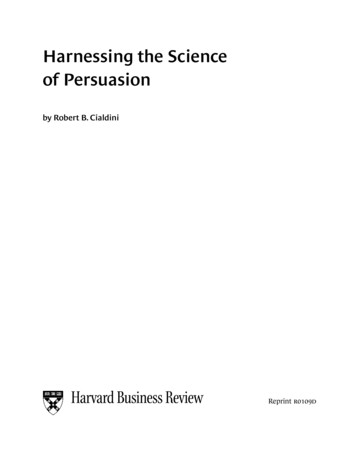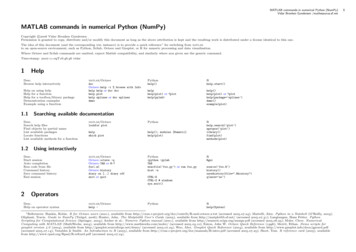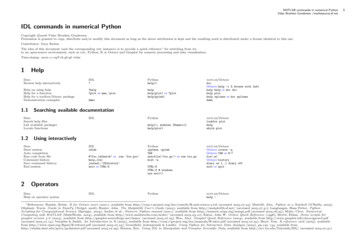
Transcription
Harnessing the Scienceof Persuasionby Robert B. CialdiniReprint r0109d
October 2001HBR Case StudyOff with His Head?r0109aDavid ChampionHBR at LargeThe Leadership Lessons of Mount Everestr0109bMichael UseemDifferent VoiceGenius at Work:A Conversation with Mark MorrisHarnessing the Science of Persuasionr0109cr0109dRobert B. CialdiniTorment Your Customers(They’ll Love It)r0109eStephen BrownRadical Change, the Quiet Wayr0109fDebra E. MeyersonYour Next IT Strategyr0109gJohn Hagel III and John Seely BrownHBR InterviewBernard Arnault of LVMH:The Perfect Paradox of Star Brandsr0109hSuzy WetlauferBest PracticeSpeeding Up Team Learningr0109jAmy Edmondson, Richard Bohmer, and Gary PisanoTool KitBoost Your Marketing ROIwith Experimental DesignEric Almquist and Gordon Wynerr0109k
Harnessing the Scienceof PersuasionAby Robert B. Cialdinilucky few have it; most of us do not. A handfulof gifted “naturals” simply know how to capture an audience, sway the undecided, andconvert the opposition. Watching these masters ofpersuasion work their magic is at once impressiveand frustrating. What’s impressive is not just the easyway they use charisma and eloquence to convinceothers to do as they ask. It’s also how eager thoseothers are to do what’s requested of them, as if thepersuasion itself were a favor they couldn’t waitto repay.The frustrating part of the experience is thatthese born persuaders are often unable to account for their remarkable skill or pass it on toothers. Their way with people is an art, andartists as a rule are far better at doing than atexplaining. Most of them can’t offer muchhelp to those of us who possess no morethan the ordinary quotient of charismaand eloquence but who still have to wrestle with leadership’s fundamental challenge: getting things done through others. That challenge is painfully familiarto corporate executives, who every dayhave to figure out how to motivateand direct a highly individualisticwork force. Playing the “Because I’mthe boss” card is out. Even if itweren’t demeaning and demoralizing for all concerned, it would beout of place in a world wherecross-functional teams, joint ventures, and intercompany partnerships have blurred the linesof authority. In such an environment, persuasion skillsexert far greater influenceover others’ behavior thanformal power structures do.72Copyright 2001 by Harvard Business School Publishing Corporation. All rights reserved.
But there’s hard science in that skill, too, and a large bodyof psychological research suggests there are six basic laws ofwinning friends and influencing people.october 2001ILLUSTRATION: SCOTT WRIGHTNo leader can succeed without mastering the art of persuasion.
H a r n e s s i n g t h e S c i e n ce o f Pe r s u a s i o nWhich brings us back to where we started. Persuasionskills may be more necessary than ever, but how can executives acquire them if the most talented practitionerscan’t pass them along? By looking to science. For the pastfive decades, behavioral scientists have conducted experiments that shed considerable light on the way certaininteractions lead people to concede, comply, or change.This research shows that persuasion works by appealingto a limited set of deeply rooted human drives and needs,and it does so in predictable ways. Persuasion, in otherwords, is governed by basic principles that can be taught,learned, and applied. By mastering these principles, executives can bring scientific rigor to the business of securingconsensus, cutting deals, and winning concessions. In thepages that follow, I describe six fundamental principles ofpersuasion and suggest a few ways that executives canapply them in their own organizations.The Principle ofLiking:People like those who like them.The Application:Uncover real similarities and offergenuine praise.The retailing phenomenon known as the Tupperwareparty is a vivid illustration of this principle in action.The demonstration party for Tupperware products ishosted by an individual, almost always a woman, who invites to her home an array of friends, neighbors, and relatives. The guests’ affection for their hostess predisposesthem to buy from her, a dynamic that was confirmed bya 1990 study of purchase decisions made at demonstration parties. The researchers, Jonathan Frenzen andHarry Davis, writing in the Journal of Consumer Research,found that the guests’ fondness for their hostess weighedtwice as heavily in their purchase decisions as their regard for the products they bought. So when guests at aTupperware party buy something, they aren’t just buying to please themselves. They’re buying to please theirhostess as well.What’s true at Tupperware parties is true for businessin general: If you want to influence people, win friends.How? Controlled research has identified several factorsthat reliably increase liking, but two stand out as espeRobert B. Cialdini is the Regents’ Professor of Psychologyat Arizona State University and the author of Influence:Science and Practice (Allyn & Bacon, 2001), now in its fourthedition. Further regularly updated information about the influence process can be found at www.influenceatwork.com.74cially compelling – similarity and praise. Similarity literally draws people together. In one experiment, reportedin a 1968 article in the Journal of Personality, participantsstood physically closer to one another after learning thatthey shared political beliefs and social values. And in a1963 article in American Behavioral Scientists, researcherF. B. Evans used demographic data from insurance company records to demonstrate that prospects were morewilling to purchase a policy from a salesperson who wasakin to them in age, religion, politics, or even cigarettesmoking habits.Managers can use similarities to create bonds with a recent hire, the head of another department, or even a newboss. Informal conversations during the workday createan ideal opportunity to discover at least one commonarea of enjoyment, be it a hobby, a college basketballteam, or reruns of Seinfeld. The important thing is to establish the bond early because it creates a presumptionof goodwill and trustworthiness in every subsequentencounter. It’s much easier to build support for a newproject when the people you’re trying to persuade are already inclined in your favor.Praise, the other reliable generator of affection, bothcharms and disarms. Sometimes the praise doesn’t evenhave to be merited. Researchers at the University ofNorth Carolina writing in the Journal of Experimental Social Psychology found that men felt the greatest regard foran individual who flattered them unstintingly even if thecomments were untrue. And in their book InterpersonalAttraction (Addison-Wesley, 1978), Ellen Berscheid andElaine Hatfield Walster presented experimental datashowing that positive remarks about another person’straits, attitude, or performance reliably generates liking inreturn, as well as willing compliance with the wishes ofthe person offering the praise.Along with cultivating a fruitful relationship, adroitmanagers can also use praise to repair one that’s damagedor unproductive. Imagine you’re the manager of a goodsized unit within your organization. Your work frequentlybrings you into contact with another manager – call himDan – whom you have come to dislike. No matter howmuch you do for him, it’s not enough. Worse, he neverseems to believe that you’re doing the best you can forhim. Resenting his attitude and his obvious lack of trustin your abilities and in your good faith, you don’t spendas much time with him as you know you should; in consequence, the performance of both his unit and yours isdeteriorating.The research on praise points toward a strategy for fixing the relationship. It may be hard to find, but there hasto be something about Dan you can sincerely admire,whether it’s his concern for the people in his department,his devotion to his family, or simply his work ethic. Inyour next encounter with him, make an appreciativecomment about that trait. Make it clear that in this caseharvard business review
H a r n e s s i n g t h e S c i e n ce o f Pe r s u a s i o nat least, you value what he values. I predict that Dan willrelax his relentless negativity and give you an opening toconvince him of your competence and good intentions.The Principle ofReciprocity:People repay in kind.The Application:Give what you want to receive.Praise is likely to have a warming and softening effect onDan because, ornery as he is, he is still human and subjectto the universal human tendency to treat people the waythey treat him. If you have ever caught yourself smiling ata coworker just because he or she smiled first, you knowhow this principle works.Charities rely on reciprocity to help them raise funds.For years, for instance, the Disabled American Veteransorganization, using only a well-crafted fund-raising letter,garnered a very respectable 18% rate of response to its appeals. But when the group started enclosing a small gift inthe envelope, the response rate nearly doubled to 35%.The gift – personalized address labels – was extremelymodest, but it wasn’t what prospective donors receivedthat made the difference. It was that they had gotten anything at all.What works in that letter works at the office, too. It’smore than an effusion of seasonal spirit, of course, thatimpels suppliers to shower gifts on purchasing departments at holiday time. In 1996, purchasing managers admitted to an interviewer from Inc. magazine that afterhaving accepted a gift from a supplier, they were willingto purchase products and services they would have otherwise declined. Gifts also have a startling effect on retention. I have encouraged readers of my book to send meexamples of the principles of influence at work in theirown lives. One reader, an employee of the State of Oregon, sent a letter in which she offered these reasons forher commitment to her supervisor:He gives me and my son gifts for Christmas and givesme presents on my birthday. There is no promotion forthe type of job I have, and my only choice for one is tomove to another department. But I find myself resisting trying to move. My boss is reaching retirement age,and I am thinking I will be able to move out after he retires. [F]or now, I feel obligated to stay since he hasbeen so nice to me.Ultimately, though, gift giving is one of the cruderapplications of the rule of reciprocity. In its more sophisticated uses, it confers a genuine first-mover advantageon any manager who is trying to foster positive attitudesoctober 2001and productive personal relationships in the office:Managers can elicit the desired behavior from coworkers and employees by displaying it first. Whether it’s asense of trust, a spirit of cooperation, or a pleasant demeanor, leaders should model the behavior they want tosee from others.The same holds true for managers faced with issues ofinformation delivery and resource allocation. If you lenda member of your staff to a colleague who is shorthandedand staring at a fast-approaching deadline, you will significantly increase your chances of getting help when youneed it. Your odds will improve even more if you say,when your colleague thanks you for the assistance, something like,“Sure, glad to help. I know how important it isfor me to count on your help when I need it.”The Principle ofSocial Proof:People follow the lead of similar others.The Application:Use peer power whenever it’s available.Social creatures that they are, human beings rely heavily on the people around them for cues on how to think,feel, and act. We know this intuitively, but intuition hasalso been confirmed by experiments, such as the one firstdescribed in 1982 in the Journal of Applied Psychology. Agroup of researchers went door-to-door in Columbia,South Carolina, soliciting donations for a charity campaign and displaying a list of neighborhood residents whohad already donated to the cause. The researchers foundthat the longer the donor list was, the more likely thosesolicited would be to donate as well.To the people being solicited, the friends’ and neighbors’ names on the list were a form of social evidenceabout how they should respond. But the evidence wouldnot have been nearly as compelling had the names beenthose of random strangers. In an experiment from the1960s, first described in the Journal of Personality and Social Psychology, residents of New York City were asked toreturn a lost wallet to its owner. They were highly likelyto attempt to return the wallet when they learned that another New Yorker had previously attempted to do so. Butlearning that someone from a foreign country had triedto return the wallet didn’t sway their decision one way orthe other.The lesson for executives from these two experimentsis that persuasion can be extremely effective when itcomes from peers. The science supports what most salesprofessionals already know: Testimonials from satisfied customers work best when the satisfied customer75
H a r n e s s i n g t h e S c i e n ce o f Pe r s u a s i o nand the prospective customer share similar circumstances. That lesson can help a manager faced with thetask of selling a new corporate initiative. Imagine thatyou’re trying to streamline your department’s workprocesses. A group of veteran employees is resisting.Rather than try to convince the employees of the move’smerits yourself, ask an old-timer who supports the initiative to speak up for it at a team meeting. The compatriot’stestimony stands a much better chance of convincing thegroup than yet another speech from the boss. Stated simply, influence is often best exerted horizontally ratherthan vertically.The Principle ofConsistency:People align with their clear commitments.The Application:Make their commitments active,public, and voluntary.Liking is a powerful force, but the work of persuasion involves more than simply making people feel warmly toward you, your idea, or your product. People need notonly to like you but to feel committed to what you wantthem to do. Good turns are one reliable way to make people feel obligated to you. Another is to win a public commitment from them.My own research has demonstrated that most people,once they take a stand or go on record in favor of a position, prefer to stick to it. Other studies reinforce that finding and go on to show how even a small, seemingly trivial commitment can have a powerful effect on futureactions. Israeli researchers writing in 1983 in the Personality and Social Psychology Bulletin recounted how theyasked half the residents of a large apartment complex tosign a petition favoring the establishment of a recreationcenter for the handicapped. The cause was good and therequest was small, so almost everyone who was askedagreed to sign. Two weeks later, on National CollectionDay for the Handicapped, all residents of the complexwere approached at home and asked to give to the cause.A little more than half of those who were not asked tosign the petition made a contribution. But an astounding92% of those who did sign donated money. The residentsof the apartment complex felt obligated to live up to theircommitments because those commitments were active,public, and voluntary. These three features are worth considering separately.There’s strong empirical evidence to show that a choicemade actively – one that’s spoken out loud or writtendown or otherwise made explicit – is considerably more76likely to direct someone’s future conduct than the samechoice left unspoken. Writing in 1996 in the Personalityand Social Psychology Bulletin, Delia Cioffi and Randy Garner described an experiment in which college students inone group were asked to fill out a printed form sayingthey wished to volunteer for an AIDS education projectin the public schools. Students in another group volunteered for the same project by leaving blank a form stating that they didn’t want to participate. A few days later,when the volunteers reported for duty, 74% of those whoshowed up were students from the group that signaledtheir commitment by filling out the form.The implications are clear for a manager who wants topersuade a subordinate to follow some particular courseof action: Get it in writing. Let’s suppose you want youremployee to submit reports in a more timely fashion.Once you believe you’ve won agreement, ask him to summarize the decision in a memo and send it to you. Bydoing so, you’ll have greatly increased the odds that he’llfulfill the commitment because, as a rule, people live upto what they have written down.Research into the social dimensions of commitmentsuggests that written statements become even more powerful when they’re made public. In a classic experiment,described in 1955 in the Journal of Abnormal and SocialPsychology, college students were asked to estimate thelength of lines projected on a screen. Some students wereasked to write down their choices on a piece of paper, signit, and hand the paper to the experimenter. Others wrotetheir choices on an erasable slate, then erased the slate immediately. Still others were instructed to keep their decisions to themselves.The experimenters then presented all three groupswith evidence that their initial choices may have beenwrong. Those who had merely kept their decisions in theirheads were the most likely to reconsider their original estimates. More loyal to their first guesses were the studentsin the group that had written them down and immediately erased them. But by a wide margin, the ones most reluctant to shift from their original choices were those whohad signed and handed them to the researcher.This experiment highlights how much most peoplewish to appear consistent to others. Consider again thematter of the employee who has been submitting late reports. Recognizing the power of this desire, you should,once you’ve successfully convinced him of the need to bemore timely, reinforce the commitment by making sure itgets a public airing. One way to do that would be to sendthe employee an e-mail that reads, “I think your plan isjust what we need. I showed it to Diane in manufacturingand Phil in shipping, and they thought it was right on target, too.” Whatever way such commitments are formalized, they should never be like the New Year’s resolutionspeople privately make and then abandon with no one thewiser. They should be publicly made and visibly posted.harvard business review
H a r n e s s i n g t h e S c i e n ce o f Pe r s u a s i o nMore than 300 years ago, Samuel Butler wrote a couplet that explains succinctly why commitments must bevoluntary to be lasting and effective: “He that compliesagainst his will/Is of his own opinion still.” If an undertaking is forced, coerced, or imposed from the outside, it’s nota commitment; it’s an unwelcome burden. Think how youwould react if your boss pressured you to donate to thecampaign of a political candidate. Would that make youmore apt to opt for that candidate in the privacy of a voting booth? Not likely. In fact, in their 1981 book Psychological Reactance (Academic Press), Sharon S. Brehm andJack W. Brehm present data that suggest you’d vote theopposite way just to express your resentment of the boss’scoercion.This kind of backlash can occur in the office, too. Let’sreturn again to that tardy employee. If you want to produce an enduring change in his behavior, you shouldavoid using threats or pressure tactics to gain his compliance. He’d likely view any change in his behavior as theresult of intimidation rather than a personal commitmentto change. A better approach would be to identify something that the employee genuinely values in the workplace – high-quality workmanship, perhaps, or teamspirit – and then describe how timely reports are consistent with those values. That gives the employee reasonsfor improvement that he can own. And because he ownsthem, they’ll continue to guide his behavior even whenyou’re not watching.The Principle ofAuthority:People defer to experts.The Application:Expose your expertise; don’t assumeit’s self-evident.Two thousand years ago, the Roman poet Virgil offeredthis simple counsel to those seeking to choose correctly:“Believe an expert.” That may or may not be good advice,but as a description of what people actually do, it can’t bebeaten. For instance, when the news media present an acknowledged expert’s views on a topic, the effect on public opinion is dramatic. A single expert-opinion news storyin the New York Times is associated with a 2% shift in public opinion nationwide, according to a 1993 study described in the Public Opinion Quarterly. And researcherswriting in the American Political Science Review in 1987found that when the expert’s view was aired on nationaltelevision, public opinion shifted as much as 4%. A cynicmight argue that these findings only illustrate the docilesubmissiveness of the public. But a fairer explanation isoctober 2001that, amid the teeming complexity of contemporary life,a well-selected expert offers a valuable and efficient shortcut to good decisions. Indeed, some questions, be theylegal, financial, medical, or technological, require so muchspecialized knowledge to answer, we have no choice butto rely on experts.Since there’s good reason to defer to experts, executives should take pains to ensure that they establish theirSurprisingly often, people mistakenlyassume that others recognize andappreciate their experience.own expertise before they attempt to exert influence. Surprisingly often, people mistakenly assume that others recognize and appreciate their experience. That’s what happened at a hospital where some colleagues and I wereconsulting. The physical therapy staffers were frustratedbecause so many of their stroke patients abandoned theirexercise routines as soon as they left the hospital. No matter how often the staff emphasized the importance ofregular home exercise – it is, in fact, crucial to the processof regaining independent function – the message justdidn’t sink in.Interviews with some of the patients helped us pinpoint the problem. They were familiar with the background and training of their physicians, but the patientsknew little about the credentials of the physical therapistswho were urging them to exercise. It was a simple matterto remedy that lack of information: We merely asked thetherapy director to display all the awards, diplomas, andcertifications of her staff on the walls of the therapyrooms. The result was startling: Exercise compliancejumped 34% and has never dropped since.What we found immensely gratifying was not just howmuch we increased compliance, but how. We didn’t foolor browbeat any of the patients. We informed them intocompliance. Nothing had to be invented; no time or resources had to be spent in the process. The staff’s expertise was real – all we had to do was make it more visible.The task for managers who want to establish theirclaims to expertise is somewhat more difficult. They can’tsimply nail their diplomas to the wall and wait for everyone to notice. A little subtlety is called for. Outside theUnited States, it is customary for people to spend time interacting socially before getting down to business for thefirst time. Frequently they gather for dinner the night before their meeting or negotiation. These get-togethers can77
H a r n e s s i n g t h e S c i e n ce o f Pe r s u a s i o nPersuasion Experts, Safe at LastThanks to several decades of rigorous empiricalresearch by behavioral scientists, our understanding of the how and why of persuasion has neverbeen broader, deeper, or more detailed. But thesescientists aren’t the first students of the subject.The history of persuasion studies is an ancientand honorable one, and it has generated a longroster of heroes and martyrs.A renowned student of social influence,William McGuire, contends in a chapter of theHandbook of Social Psychology, 3rd ed. (OxfordUniversity Press, 1985) that scattered among themore than four millennia of recorded Westernhistory are four centuries in which the study ofpersuasion flourished as a craft. The first was thePericlean Age of ancient Athens, the second occurred during the years of the Roman Republic,the next appeared in the time of the EuropeanRenaissance, and the last extended over the hundred years that have just ended, which witnessedthe advent of large-scale advertising, information,and mass media campaigns. Each of the threeprevious centuries of systematic persuasion studywas marked by a flowering of human achievement that was suddenly cut short when politicalauthorities had the masters of persuasion killed.The philosopher Socrates is probably the bestknown of the persuasion experts to run afoul ofthe powers that be.Information about the persuasion process is athreat because it creates a base of power entirelyseparate from the one controlled by political authorities. Faced with a rival source of influence,rulers in previous centuries had few qualmsabout eliminating those rare individuals whotruly understood how to marshal forces thatheads of state have never been able to monopolize, such as cleverly crafted language, strategically placed information, and, most important,psychological insight.It would perhaps be expressing too much faithin human nature to claim that persuasion expertsno longer face a threat from those who wield political power. But because the truth about persuasionis no longer the sole possession of a few brilliant,inspired individuals, experts in the field can presumably breathe a little easier. Indeed, since mostpeople in power are interested in remaining inpower, they’re likely to be more interested in acquiring persuasion skills than abolishing them.78make discussions easier and help blunt disagreements –remember the findings about liking and similarity – andthey can also provide an opportunity to establish expertise. Perhaps it’s a matter of telling an anecdote aboutsuccessfully solving a problem similar to the one that’s onthe agenda at the next day’s meeting. Or perhaps dinneris the time to describe years spent mastering a complexdiscipline – not in a boastful way but as part of the ordinary give-and-take of conversation.Granted, there’s not always time for lengthy introductory sessions. But even in the course of the preliminaryconversation that precedes most meetings, there is almostalways an opportunity to touch lightly on your relevantbackground and experience as a natural part of a sociableexchange. This initial disclosure of personal informationgives you a chance to establish expertise early in thegame, so that when the discussion turns to the business athand, what you have to say will be accorded the respect itdeserves.The Principle ofScarcity:People want more of what they can have less of.The Application:Highlight unique benefits andexclusive information.Study after study shows that items and opportunities areseen to be more valuable as they become less available.That’s a tremendously useful piece of information formanagers. They can harness the scarcity principle withthe organizational equivalents of limited-time, limitedsupply, and one-of-a-kind offers. Honestly informing acoworker of a closing window of opportunity–the chanceto get the boss’s ear before she leaves for an extended vacation, perhaps – can mobilize action dramatically.Managers can learn from retailers how to frame theiroffers not in terms of what people stand to gain but interms of what they stand to lose if they don’t act on the information. The power of “loss language” was demonstrated in a 1988 study of California home owners writtenup in the Journal of Applied Psychology. Half were toldthat if they fully insulated their homes, they would savea certain amount of money each day. The other half weretold that if they failed to insulate, they would lose thatamount each day. Significantly more people insulatedtheir homes when exposed to the loss language. The samephenomenon occurs in business. According to a 1994study in the journal Organizational Behavior and HumanDecision Processes, potential losses figure far more heavilyin managers’ decision making than potential gains.harvard business review
H a r n e s s i n g t h e S c i e n ce o f Pe r s u a s i o nIn framing their offers, executives should also remember that exclusive information is more persuasive thanwidely available data. A doctoral student of mine, AmramKnishinsky, wrote his 1982 dissertation on the purchasedecisions of wholesale beef buyers. He observed that theymore than doubled their orders when they were told that,because of certain weather conditions overseas, there waslikely to be a scarcity of foreign beef in the near future.But their orders increased 600% when they were informed that no one else had that information yet.The persuasive power of exclusivity can be harnessedby any manager who comes into possession of information that’s not broadly available and that supports an ideaor initiative he or she would like the organization toadopt. The next time that kind of information crossesyour desk, round up your organization’s key players. Theinformation itself may seem dull, but exclusivity will giveit a special sheen. Push it across your desk and say,“I justgot this report today. It won’t be distributed until nextweek, but I want to give you an early look at what itshows.” Then watch your listeners lean forward.Allow me to stress here a point that should be obvious.No offer of exclusive information, no exhortation to actnow or miss this opportunity forever should be made unless it is genuine. Deceiving colleagues into compliance isnot only ethically objectionable, it’s foolhardy. If the deception is detected – and it certainly will be – it will snuffout any enthusiasm the offer originally kindled. It willalso invite dishonesty toward the deceiver. Remember therule of reciprocity.Putting It All TogetherThere’s nothing abstruse or obscure about these six principles of persuasion. Indeed, they neatly codify our intuitive understanding of the ways peop
Harnessing the Science of Persuasion Robert B. Cialdini is the Regents'Professor of Psychology at Arizona State University and the author of Influence: Science and Practice(Allyn & Bacon,2001),now in its fourth edition.Further regularly updated information about the in-fluence process can be found at www.influenceatwork.com. The Principle of










